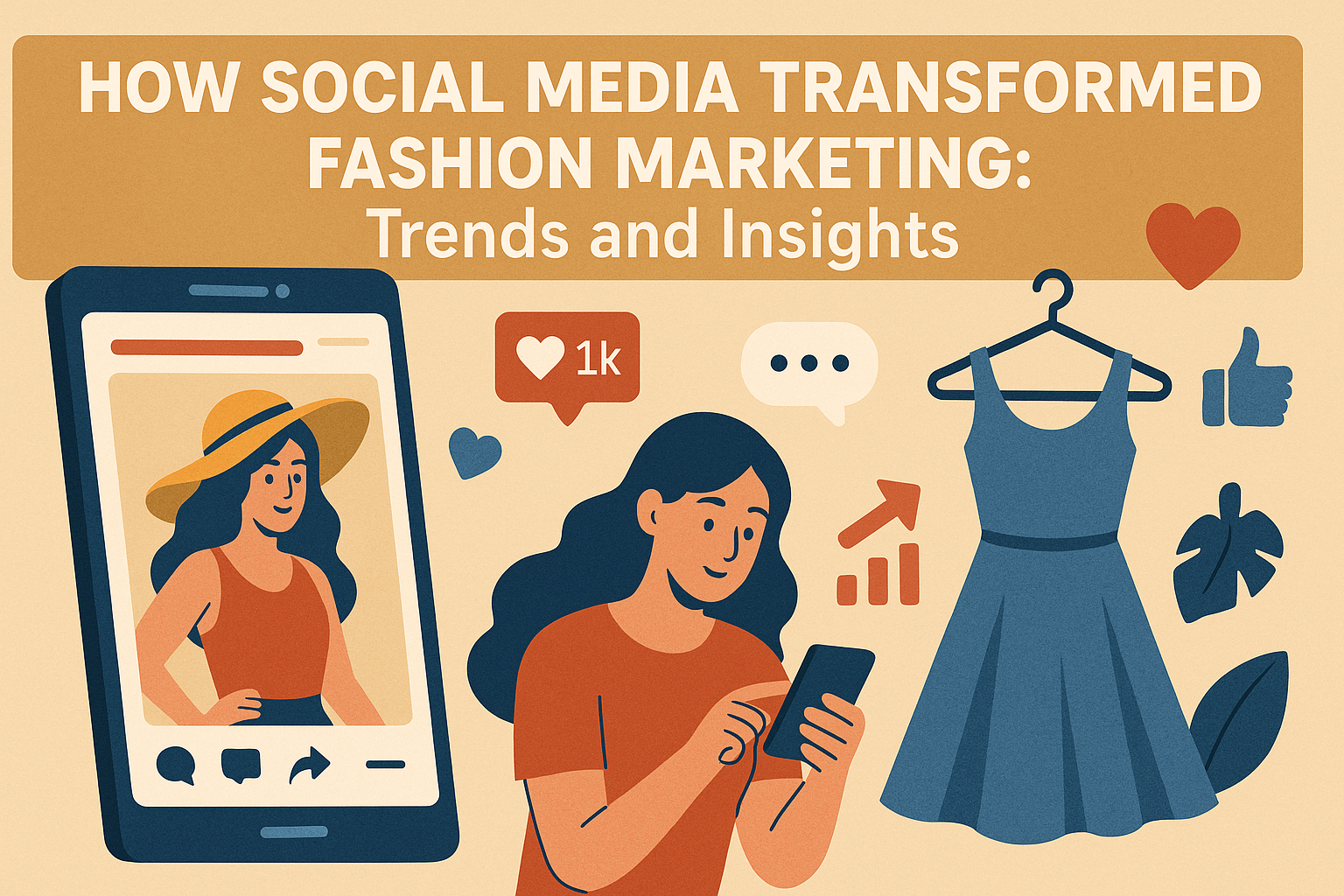Introduction
Fashion marketing has experienced a significant transformation in the current fast-moving digital environment because social media has become prominent. As both a fashion enthusiast and brand owner or marketer understanding the social media effect on this industry becomes mandatory. This blog explores the major developments which transformed fashion marketing through social media while showing you ways to grow your own brand with these changes.
The Shift in Fashion Marketing Paradigms
Understanding the dramatic changes social media brought to fashion marketing requires consideration of previous marketing practices. In previous times fashion marketing depended completely on billboards together with print advertisements and television commercials to spread their message. Practices from the past involved huge financial allocations for professional models to display luxury designer fashion in luxury publication spreads. The marketing strategies from decades ago succeeded despite their absence of real-time connectivity which social media provides as the present standard.
Social media platforms Instagram and TikTok and Pinterest have brought a complete transformation to the fashion marketing industry. Research from Hootsuite indicates that worldwide social media users reached 4.7 billion by 2023 while Instagram leads fashion marketing since 80 percent of users follow at least one brand. Such changes in fashion marketing have opened new avenues of customer engagement since brands can now interact with their targets through direct platforms.
Key Trends in Social Media Fashion Marketing
Influencer Marketing
Social media fashion marketing has experienced a major shift through the expansion of influencer marketing as one of its most important developments. Social media influencers who command large audiences have evolved into conductors of fashion tendencies as well as consumer cultural practices. Brands use influencers to advertise their products where influencers rely on their established reach and trustworthiness to market the products.
The #FashionInfluencer label on social media demonstrates millions of posts which reveals the great influence influencers maintain over decision-making for consumer purchases. The high demand for influencers to partner with Fashion Nova along with PrettyLittleThing enabled these brands to showcase their products effectively through genuine environments. The brand achieved higher sales numbers and established a loyal community base because of this approach.
User-Generated Content
The second major effect of social media on fashion marketing stems from User-Generated Content (UGC). UGC describes content of any format—images or reviews alongside videos—when consumers generate these materials instead of brand representatives. Social media users have become extremely enthusiastic about UGC because they want genuine interactions when shopping.
Modern brands invite their customers to display product photos which builds communities while supplying genuine promotional content. Aerie launched #AerieREAL as an advertising campaign that uses actual customers in their products to build sales and spread body acceptance and diversity messages. The brand loyalty enhancement combined with the attraction of new customers who identify with the brand values makes this approach successful.
Visual Storytelling
Visual nature of fashion suits storytelling activities on platforms such as Instagram and Pinterest. Brands dedicate their efforts toward building visual storytelling structures which connect to their target audience. High-quality visuals that include images, videos along with graphic elements serve as crucial tools to catch viewers’ attention in an overpopulated feed.
The social media channels of Dior and Gucci display perfectly curated content which represents their established brand visual approach. Visual storytelling enables the brands to build emotional bonds with their audience which promotes more engagement and content sharing from audience members.
Short-Form Video Content
Fashion marketing experiences a significant shift through short-form video content which Instagram Reels and TikTok bring to the market. The short mobile video clips enable brands to demonstrate products and deliver fashion advice and build connections with their audience base.
TikTok functions as a valuable collection of all the current fashion trends and thousands of users follow viral challenges that utilize particular garments and fashion choices. Users have adopted the “Get Ready With Me” trend on social media platforms to show their outfit selections in a friendly approachable style. Zara and ASOS along with other brands use TikTok to promote new collections through their own video content as they target younger consumer demographics.
Social Media Strategies for Effective Fashion Marketing

Moving forward we can analyze practical methods which will enable you to maximize social media power within your fashion marketing initiatives.
Target Audience Identification
Learning about your reader demographic represents the fundamental requirement for producing successful fashion marketing. When you understand the customers who buy from your brand you can produce content which matches their interests in their social networks.
Carbonize audience data from Google Analytics along with social media analytics to acquire demographic along with preference information about your audience. The gathered data will serve as your guiding force for making marketing choices while you develop materials that appeal to your audience.
Content Planning and Scheduling
The responsibility of sustaining a permanent social media profile depends heavily on using a content calendar. Preplanning your social media posts helps maintain regular content distribution which follows your marketing objectives.
The platform tools Buffer and Hootsuite enable you to schedule social media posts which will free up time for producing high-quality content material. Your content should have variety since promotional content works best when surrounded by interesting material such as user-submitted items and behind-the-scenes moments that draw audience attention.
Engagement and Community Building
Through social media you construct new social connections. You should engage your audience by reacting to their comments then ask interesting questions which also stimulate discussion.
Building brand-based communities with your audience enables stronger brand ties that motivates people to promote your content. Design contests and challenges that activate users to join and promote their product encounters with your brand. Expanding your reach becomes possible as your followers develop the habit of tagging their friends on your content.
Analytics and Performance Measurement
Your fashion marketing strategy requires social media performance tracking as the only way to identify successful and unsuccessful tactics. You should monitor crucial indicators which include engagement rates and website traffic statistics as well as conversion rates.
The performance analytics tools accessible from Google Analytics and social media platforms deliver essential behavioral insights about audience members. Analyze the collected data to adjust your approach toward content that your followers demonstrate interest in.
Challenges and Limitations of Social Media in Fashion Marketing
Fashion marketing can benefit tremendously from social media platforms but businesses must face specific obstacles that arise from using this platform.
Changing Algorithms
Brands currently experience severe challenges because social media algorithms frequently transform without warning. Brand reach can substantially decrease because these algorithms decide which content reaches the users.
You should produce premium content of high quality that triggers audience interaction. The algorithms tend to prefer engaging posts because they help brands stay visible to their followers.
Saturation and Competition
Brands face enormous competition for social media engagement because numerous businesses fight to gain viewer attention. Numerous fashion content available today presents an obstacle for staying visible to your target audience.
Your brand will stand out if you place focus on points which uniquely define your brand. Your brand message should exist prominently in content material which displays your sustainability leadership and distinctive fashion approach along with exceptional customer care principles.
Negative Feedback and Brand Reputation
Social media brings both opportunities to connect with customers through engagement and the risk of getting negative feedback. The digital transformation introduces the risk that a single negative message can rapidly grow into damaging your brand reputation.
Your plan should include efficient procedures to handle negative feedback with a professional approach. Handle incoming concerns by validating concerns properly while expressing remorse when needed followed by transitioning skeptical comments to direct communication channels. The practice of visibility serves as a method to restore trust between businesses and their audience.
Future Trends in Fashion Marketing through Social Media
Social media shows no signs of reducing its influence on the world of fashion marketing during future periods. The following trends will define the future of social media in the fashion industry.
Emerging Technologies
The fashion marketing industry sees escalating adoption of augmented reality (AR) and virtual reality (VR) technological developments. Brands implement AR to develop virtual try-on tools which let customers preview their selections before buying products.
Customers who use Sephora Virtual Artist can experience virtual make-up tests through AR technology while the same concept may apply directly to the fashion industry to provide improved shopping experiences and lower return rates.
Sustainability and Ethical Fashion
Consumers from today focus on sustainability together with ethical production methods in fashion. Through social media brands successfully articulate their dedication toward essential values to their audiences.
Socially conscious shoppers will connect with brands when these companies present their initiatives regarding sustainable practices as well as ethical sourcing and visible supply chain operations. A McKinsey survey proved that 67 percent of consumers are willing to spend more money on brands which emphasize sustainable practices. Brands need to incorporate active social media presentations of their sustainability practices because this market trend shows no signs of diminishing.
Conclusion
Social media technologies have spearheaded fashion marketing into a fascinating evolution which demonstrates how people connect with technology. Brands can build meaningful audience connections through their implementation of current marketing approaches such as influencer endorsements alongside audience-generated posts and bite-sized video content.
Your journey through this digital realm depends on audience understanding, content creation excellence and community development. The limitless potential of innovative connections exists despite present difficulties.
Your fashion marketing strategy will rise to new heights through social media implementation which all types of fashion professionals should deploy. With exciting opportunities ahead in fashion you will find your distinctive voice followed by a bright future.

